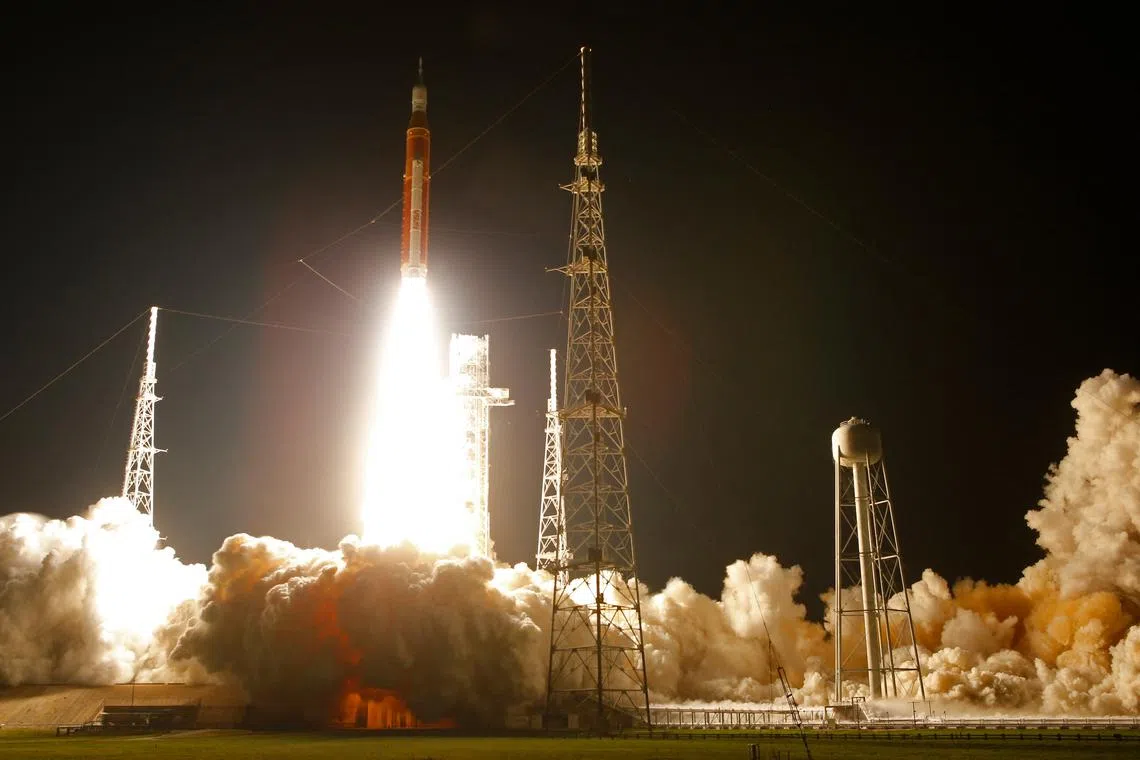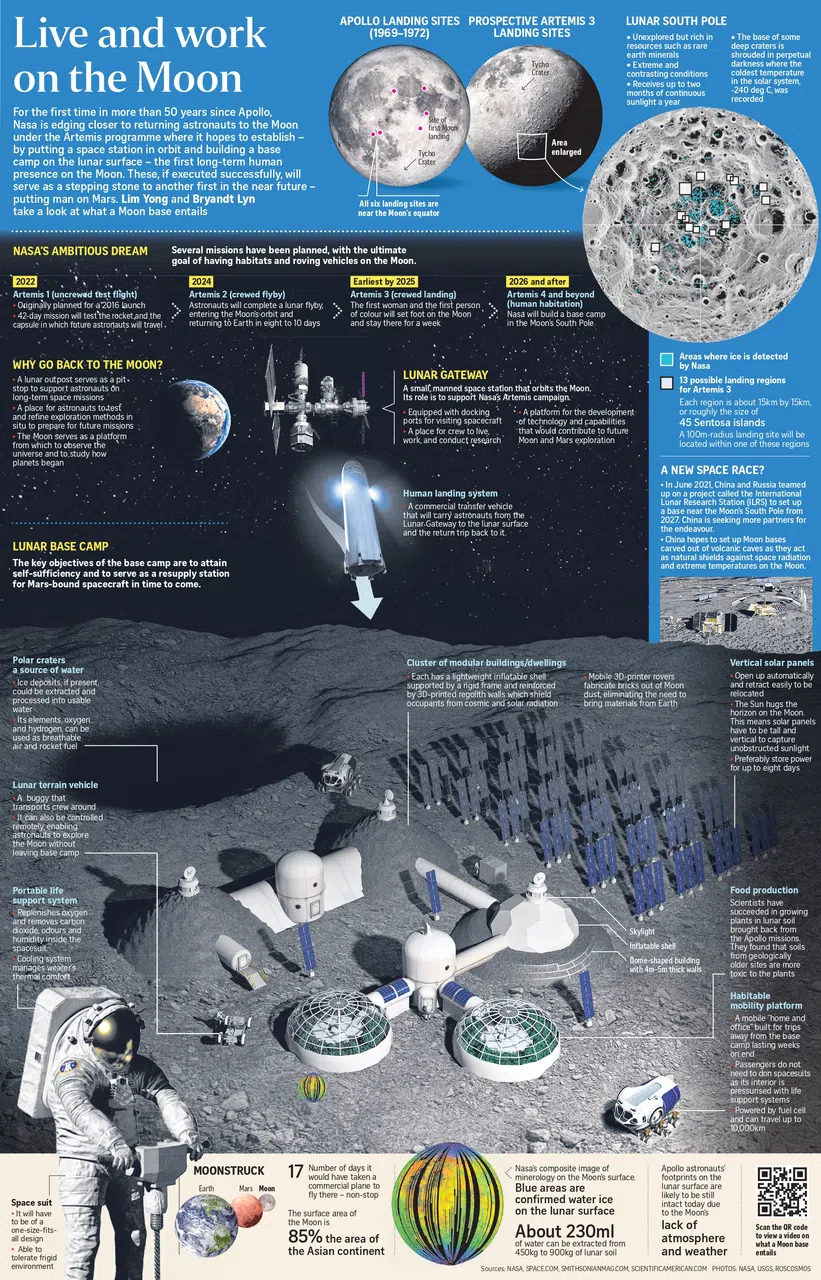Nasa’s next-generation Artemis rocket lifts off on test flight to Moon
Sign up now: Get ST's newsletters delivered to your inbox

The Space Launch System rocket with the Orion crew capsule on the unmanned Artemis 1 mission to the moon on Nov 16, 2022.
PHOTO: REUTERS
Follow topic:
CAPE CANAVERAL, Florida – American space agency Nasa’s next-generation rocketship was on course for a crewless voyage around the Moon and back, launched from Florida on its debut flight half a century after the final lunar mission of the Apollo era.
The much-delayed launch kicked off Apollo’s successor programme Artemis, aimed at returning astronauts to the lunar surface this decade and establishing a sustainable base there as a stepping stone to future human exploration of Mars.
The 32-storey Space Launch System (SLS) rocket surged off the launch pad from the Kennedy Space Centre in Cape Canaveral on Wednesday to send its Orion capsule on a three-week test journey around the Moon and back without astronauts aboard.
“Today, we got to witness the world’s most powerful rocket take the Earth by its edges... And it was quite a sight,” Artemis mission manager Mike Sarafin told a post-launch Nasa briefing. Aside from some minor instrument issues, “this system is performing exactly as we intended it to”, he said.
Lift-off came on the third attempt at launching the long-delayed, multibillion-dollar rocket, after 10 weeks beset by numerous technical mishaps, back-to-back hurricanes and two fruitless excursions trundling the spacecraft out of its hangar to the launch pad.
Dubbed Artemis I, the mission marks the first flight of the SLS rocket and the Orion capsule together, built by Boeing and Lockheed Martin, respectively, under contract with Nasa. It also signals a major change in direction for Nasa’s post-Apollo human spaceflight programme after decades focused on low-Earth orbit with space shuttles and the International Space Station.
Moon shot in 2025
Named for the ancient Greek goddess of the hunt – and Apollo’s twin sister – Artemis aims to return astronauts to the Moon’s surface as early as 2025.
Twelve astronauts walked on the Moon during six Apollo missions from 1969 to 1972, the only space flights yet to place humans on the lunar surface. But Apollo, born of the Cold War-era space race between the United States and the then Soviet Union, was less science-driven than Artemis.
The new Moon programme has enlisted commercial partners such as billionaire Elon Musk’s SpaceX and the space agencies of Europe, Canada and Japan to eventually establish a long-term lunar base as a stepping stone to even more ambitious human voyages to Mars.
The Artemis I countdown climaxed with the rocket’s four main R-25 engines and its twin solid-rocket boosters roaring to life, sending the spacecraft streaking skywards and lighting up the night sky over Florida’s central Atlantic coast.
About 90 minutes after launch, the rocket’s upper stage is designed to loft Orion out of Earth orbit on course for a 25-day flight that will bring it to within 97km of the lunar surface before sailing nearly 64,400km beyond the Moon and back to Earth.
The capsule is expected to splash down on Dec 11.
Stress test
Getting the SLS-Orion spacecraft off the ground was a key hurdle for the ambitious Artemis programme. Its first voyage is intended to put the vehicle through its paces in a rigorous test flight, pushing its design limits to prove the spacecraft is suitable to fly astronauts.
If the mission succeeds, a crewed Artemis II flight around the Moon and back could come as early as 2024, followed within a few more years by the programme’s first lunar landing of astronauts, one of them a woman, with Artemis III.
Billed as the most powerful, complex rocket in the world, the SLS represents the biggest new vertical launch system Nasa has built since Saturn V of the Apollo era.

Although no people were aboard, Orion carried a simulated crew of three – one male and two female mannequins – fitted with sensors to measure radiation levels and other stresses that astronauts would experience.
A top objective is to test the durability of Orion’s heat shield during re-entry as it hits Earth’s atmosphere at 39,429km per hour, or 32 times the speed of sound, on its return from lunar orbit – much faster than re-entries from the space station.
The heat shield is designed to withstand re-entry friction expected to raise temperatures outside the capsule to nearly 2,760 deg C.
The spacecraft is also set to release a payload of 10 miniaturised science satellites, called CubeSats, including one designed to map the abundance of ice deposits on the Moon’s south pole, where Artemis seeks to eventually land astronauts.
Sending astronauts to Mars, an order of magnitude more challenging than lunar landings, is expected to take at least another decade and a half to achieve.
More than a decade in development with years of delays and budget overruns, the SLS-Orion spacecraft has so far cost Nasa at least US$37 billion (S$51 billion), including design, construction, testing and ground facilities.
Nasa’s Office of Inspector-General has projected total Artemis costs at US$93 billion by 2025.
Nasa calls the programme a boon to space exploration that has generated tens of thousands of jobs and billions of dollars in commerce. REUTERS


